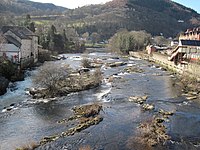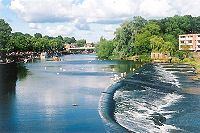River Dee
The River Dee (Welsh: Afon Dyfrdwy) is a river that flows from Merionethshire to Cheshire, 70 miles long from its source in the mountains until the Dee Estuary enters the Irish Sea.
The Dee rises on the slopes of Dduallt above Llanuwchllyn in the mountains of Merionethshire and flows generally eastward. By the time it reaches Chester it is a large, tidal river and very soon opens up into a broad estuary between Flintshire and the Wirral peninsula of Cheshire.
Contents
Natural course of the river
From its source on the slopes of Dduallt in the mountains of Merionethshire, the Dee runs north-eastwards forging a valley to Bala Lake. Local legend says that the waters of the Dee pass from one end of the lake to the other unmixed with the water of the lake itself and remarkably a hydrographic survey was one made to test this, and proved it a mere romantic tale.
From the lower end of Bala Lake the river is disgorged once again and flows generally east-south-east as it descends off the Ordovician rocks of the Denbigh Moors. After forming the county border with Denbighshire for a while the Dee definitively enters the county in the meander before Rhewl, and after looping back on itself to Llantysilio it tumbles over the man-made Horseshoe Falls and goes on to Llangollen. The river is forced around the outcrops of Karstic limestone exposures north of Llangollen.
East of Llangollen, Thomas Telford's dramatic Pontcysyllte Aqueduct, of 1805, carries the Shropshire Union Canal 120 feet overhead.
Further downstream the Dee then forms part of Denbighshire's border with Shropshire and then with the Maelor Saesneg portion of Flintshire, either side of Bangor-on-Dee. Downstream of Bangor the river soon becomes the natural border between Flintshire and Cheshire, a role it performs for several miles as it meanders between the twin villages of Holt, Denbighshire and Farndon, Cheshire where a mediæval sandstone bridge stands at an important crossing point.
One of the major tributaries of the Dee, the River Alyn crosses the Carboniferous Limestone from Halkyn Mountain and runs down through the Loggerheads area before discharging itself into the Dee north of Holt. Throughout the length of the Alyn there are numerous swallow holes and caverns including the well-known caves of Ogof Hesp Alyn and Ogof Hen Ffynhonnau, and during the summer months long stretches of the river bed run dry as the water disappears underground. A significant part of this lost flow re-emerges in the Milwr Tunnel, a man-made tunnel, entering the west bank of the Dee estuary and carrying 12 million imperial gallons a day. The tunnel was originally built to drain metal mines in Halkyn Mountain.
Approaching Aldford, the Dee passes entirely into Cheshire, then flows under the A55 road and continues northwards to Chester.
At Chester the river passes and around the Earl's Eye(s) meadow. In the vicinity of Chester the riverside is used as a recreation area with a bandstand, benches and boat cruises, being crossed by four bridges. The first is the Queen's Park Suspension Bridge, which forms the only exclusively pedestrian footway across the river in Chester. The second is the Old Dee Bridge, a road bridge and by far the oldest bridge in Chester, being built in about 1387 on the site of a series of wooden predecessors which dated originally from the Roman period.
Above the Old Dee Bridge is Chester Weir, which was built by Hugh Lupus to supply power to his corn mills. Throughout the centuries the weir has been used to power corn, fulling, needle, snuff and flint mills. The same weir was used as part of a hydro-electric scheme in 1911 with the help of a small generator building which is still visible today, used as a pumping station for water since 1951. However the first water pumping station here was set up in 1600 by John Tyrer who pumped water to a square tower built on the city's Bridgegate. It was destroyed in the Civil War but an octagonal tower built in 1690 for the same purpose lasted until the gate was replaced with an arch in the mid-18th century.
On this weir is a fish pass and fish counting station to monitor the numbers of salmon ascending the river, and also a weirgate for navigating the weir at spring tides. A little further downstream stands the Grosvenor Bridge (designed by architect Thomas Harrison of Chester), which was opened in 1833 to ease congestion on the Old Dee Bridge. This bridge was opened by Princess Victoria five years before she became Queen.
The other side of the Grosvenor Bridge is the Roodee, Chester's race course and the oldest course in the country. This used to be the site of Chester's Roman harbour until, aided by the building of the weir, the River Dee silted up to become the size it is today. The only curiously remaining reminder of this site's maritime past is a stone cross which stands in the middle of the Roodee which exhibits the marks of water ripples. To the end of the Roodee the river is crossed by Chester's fourth bridge which carries the Chester–Holyhead railway line, before leaving Chester. It was the scene of one of the first serious railway accidents in the country, the Dee Bridge Disaster.
Canalised section
West of Chester, the river flows along an artificial channel excavated between 1732-1736. The work was planned and undertaken by engineers from the Netherlands and paid for by local merchants and Chester Corporation. It was an attempt to improve navigation for shipping and reduce silting. Chester's trade had declined steadily since the end of the 17th century as sediment had prevented larger craft reaching the city.
After four years' work, the river was diverted from its meandering natural course which passed Blacon, Saughall, Shotwick Castle, Burton and Parkgate and up the west shore of the Wirral. Instead the new canalised section followed the Flintshire coast. During this time, Sealand and Shotton were reclaimed from the estuary. Land reclamation in this area continued until 1916. The river's natural course can still be determined by following the bank and low bluffs that mark the western edge of the Wirral Peninsula.
The man-made channel, which runs in a straight line for five miles, passes beneath three road bridges. The first two are adjacent to each other at Queensferry. They are a 1960s fixed-arch bridge carrying the A494 trunk road and its predecessor the New Jubilee Bridge, which is a rolling Bascule bridge completed in 1926. The third crossing, and the most recent, is at Connah's Quay. The Flintshire Bridge is a fixed cable-stayed bridge. It opened in 1999.
Between the second and third road bridges is Hawarden railway bridge, originally constructed as a swing bridge but now never opened. It carries the Birkenhead – Wrexham "Borderlands Line" over the river.
A footbridge replaced the passenger ferry at Saltney in the 1970s.
Estuary
Beyond Connah's Quay, the river opens out into the Dee Estuary, forming the north-easternmost section of the Flintshire coast and the western coast of the Wirral. Towns along the coast include Flint, Holywell and Mostyn on the Flintshire side and Neston, Parkgate, West Kirby and Hoylake on the Wirral side.
The estuary is hugely important for birdlife and has been designated both as an SSSI and as a Ramsar site accordingly. Its value lies in the huge expanses of mud which are exposed between tides and the extensive saltmarsh developed on both sides but principally on the right bank north and south of Neston.
The estuary owes its origins to the scouring of a broad channel through the Triassic sandstones and Carboniferous mudstones by glacial ice during successive ice ages to form an iceway. The channel continues inland south of Chester but its higher reaches have long since been infilled with sand, gravel and mud. The process of infilling by mud continues to the present day as the rapid growth of the saltmarsh in the last century testifies, pushing the high tide line further out into the estuary.
Sport
Fishing
The river has been famed as a mixed fishery with salmon and trout fishing, mostly in the upper waters and a good coarse fishery in the lower reaches. A major pollution incident in the middle reaches in the late 1990s did extensive damage to the fishery from which it is now largely recovered.
Water sports
The Dee used to be a popular whitewater kayaking and touring river (particular the grade III/IV whitewater section upstream of Llangollen). It stays high after rain for longer than most British rivers and is paddleable year-round (thanks to the River Dee Regulation System). Canoeing used to be allowed on about twelve weekends per year, and tens of thousands of canoeists descended on Llangollen for recreational paddling (several Dee tours were held every winter), slalom competitions, and wild water races.
Public access to the river is arranged by the Welsh Canoe Association. In 2003, negotiations with the angling associations owning fishing rights on the Dee broke down. The anglers wanted to restrict the numbers of paddlers on the river when paddling was allowed but the Welsh Canoe Association wanted to renew the previous agreement. As a result, all canoeing on the river was banned. In November 2004, a protest about the lack of access on the Dee, and to rivers across England and Wales, was held in Llangollen. After the failure of the access agreement, many canoeists use the river at will from the numerous access points along its banks.
Canoeing is permitted on one 100-yard rapid a little upstream of Llangollen, and on some flat sections far downstream in Cheshire.
Each July the Chester Raft Race is held on the River Dee in aid of charity.
Industry
Large parts of the catchment are devoted to agriculture and there a number of abstractions made from the river for summer irrigation, though the volumes involved are not significant.
From Chirk downstream, the river valley has supported a wide range of industries that were initially drawn to the area by the presence of coal mines and later by the deep deposits of clays used to make bricks and tiles. The coal industry in particular gave rise to a number of chemical industries some of which survive to this day and which both take water from the river and discharge their cleaned up effluent back into the river.
Industries in the valley include commercial chemicals manufacturer, wood chip and MDF fabrication, cocoa milling, fibreglass manufacture, waste disposal (in old clay pits) and a great variety of smaller industries concentrated around Wrexham. The main impact on the river of these industries is their thirst for a dependable good quality water supply.
Currently the wings for the Airbus A380, which are made at Airbus' manufacturing factory in Broughton, are taken downriver by barge to the Port of Mostyn because they are too large to be shipped in an Airbus Beluga.[1] The dredging of the river for the barge may be responsible for a weakening of the tidal bore.
Outside links
- River Dee guide
- Dee Estuary bird life
- Dee Estuary photos
- The adventures of a salmon in the river Dee (1853)
References
- ↑ "Marine Safety in the Dee Conservancy" (PDF). Environment Agency Wales. http://216.31.193.170/commondata/acrobat/deeconsafety_1169122.pdf.
Books
- G.W. Place, The Rise and Fall of Parkgate, Passenger Port for Ireland (1994).
- Gordon Emery, Curious Chester (1999) ISBN 1-872265-94-4
- Gordon Emery, Chester Inside Out (1998) ISBN 1-872265-92-8
- Gordon Emery, The Chester Guide(2003) ISBN 1-872265-89-8
- ed Gordon Emery, The Old Chester Canal ISBN 1-872265-88-X
- Gordon Emery, Chester Electric Lighting Station (2002) ISBN 1-872265-48-0
- Roy Wilding, Miller of Dee (1997) ISBN 1-872265-95-2
- Roy Wilding Death in Chester (2003) ISBN 1-872265-44-8
- PR Lewis, Disaster on the Dee: Robert Stephenson's Nemesis of 1847, Tempus Publishing (2007) ISBN 978 0 7524 4266 2








